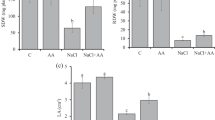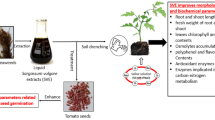Abstract
The morphological and physiological parameters were measured for 15 green bean genotypes, and enzymatic activities were measured for two genotypes (tolerant and sensitive) grown under controlled greenhouse conditions during waterlogging stress and recovery periods. Plants were exposed to waterlogging stress for 7 days followed by 7 days of recovery. The leaf area and color, leaf relative water content and turgid losses, and the degree of cell membrane injury were determined. ‘Şeker Fasulye’ genotype was relatively tolerant among the genotypes studied. Besides, waterlogging treatment caused the loss of sampled organs in the sensitive genotypes, ‘40 Günlük’, ‘L3’, and ‘L4’. After these three genotypes, the ‘L1’ genotype was found to be sensitive. Therefore, enzymatic activities were measured for ‘Şeker Fasulye’ and ‘L1’. Nicotinamide adenine dinucleotide phosphate oxidase [NAD(P)H oxidase, EC.1.6.3.1] activity increased during waterlogging treatment and decreased during the recovery period. To the contrary, waterlogging treatment degraded catalase (CAT, EC.1.11.1.6) and glutathione reductase (GR, EC.1.6.4.2) activities in leaves and roots. The activity of both enzymes increased during recovery treatment. In conclusion, leaf area, cell membrane injury, and stress-related enzyme activities were found to be an effective means for determining a green bean genotype’s response to waterlogging stress.
Similar content being viewed by others
Literature Cited
Ahmed, F., M.Y. Rafii, M.R. Ismail, A.S. Juraimi, H.A. Rahim, R. Asfaliza, and M.A. Latif. 2013. Waterlogging tolerance of crops: Breeding, mechanism of tolerance, molecular approaches, and future prospects. BioMed. Res. Int. 2013:1–10.
Ahmed, S., E. Nawata, M. Hosokawa, Y. Domae, and T. Sakuratani. 2002. Alterations in photosynthesis and some antioxidant enzymatic activities of mungbean subjected to waterlogging. Plant Sci. 163:117–123.
Aloni, B. and G. Rosenshtein. 1982. Effect of flooding on tomato cultivars: The relationship between proline accumulation and other morphological and physiological changes. Physiol. Plant. 56:513–517.
Arbona, V., Z. Hossain, M.F. Lopez-Climent, R.M. Perez-Clemente, and A. Gomez-Cadenas. 2008. Antioxidant enzymatic activity is linked to waterlogging stress tolerance in citrus. Physiol. Plant. 132:452–466.
Arora, R., D.S. Pitchay, and B.C. Bearce. 1998. Water-stress-induced heat tolerance in Geranium leaf tissues: A possible linkage through stress proteins? Physiol. Plant. 103:24–34.
Arora, R., M.E. Wisniewski, and R. Scorza. 1992. Cold acclimation in genetically related (sibling) deciduous and evergreen peach [Prunus persica (L.) Batsch] I: Seasonal changes in cold-hardiness and polypeptides of bark and xylem tissues. Plant Physiol. 99:1562–1568.
Aydoğan, Ç. and E. Turhan. 2012. The effects of waterlogging stress and recovery treatment on some common bean genotypes GOÜ. Ziraat Fakültesi Dergisi. 29:41–51. (in Turkish)
Barrs, H.D. and P.E. Weatherley. 1962. A re-examination of the relative turgidity technique for estimating water deficit in leaves. Austral. J. Biol. Sci. 15:413–428.
Blokhina, O., E. Virolainen, and K.V. Fagerstedt. 2003. Antioxidants, oxidative damage and oxygen deprivation stress: A review. Ann. Bot. 91:179–194.
Bradford, M.M. 1976. A rapid and sensitive method for quantitation of microgram quantities of protein utilizing the principle of proteindye binding. Anal. Biochem. 72:248–254.
Cakmak, I. and H. Marschner. 1988. Zinc-dependent changes in ESR signals, NADPH oxidase and plasma membrane permeability in cotton roots. Physiol. Plant. 73:182–186.
Cakmak, I. and H. Marschner. 1992. Magnesium deficiency and high-light intensity enhance activities of superoxide dismutase, ascorbate peroxidase and glutathione reductase in bean leaves. Plant Physiol. 98:1222–1227.
Çelik, G. 2010. Determination of tolerance to excess water in root regions of some green bean genotypes. MS Thesis. Eskişehir Osmangazi University, Turkey. (in Turkish).
Celik, G. and E. Turhan. 2011. Genotypic variation in growth and physiological responses of common bean (Phaseolus vulgaris L.) seedlings to flooding. Afr. J. Biotechnol. 10:7372–7380.
Chen, H., M.F. Zamorano, and D. Ivanoff. 2010. Effect of flooding depth on growth, biomass, photosynthesis, and chlorophyll fluorescence of Typha domingensis. Wetlands 30:957–965.
Dat, J.F., N. Capelli, H. Folzer, P. Bourgeade, and P.M. Badot. 2004. Sensing and signalling during plant flooding. Plant Physiol. Biochem. 42:273–282.
Edwards, E.A., S. Rawsthorne, and P.M. Mullineaux. 1990. Subcellular distribution of multiple forms of glutathione reductase in leaves of pea (Pisum sativum L.). Planta 180:278–284.
Else, M.A., F. Janowiak, C.J. Atkinson, and M.B. Jackson. 2009. Root signals and stomatal closure in relation to photosynthesis, chlorophyll a fluorescence adventitious rooting of flooded tomato plants. Ann. Bot. 103:313–323.
FAO. 2015. Food and agriculture organization of the united nations, statistics division. http://faostat3.fao.org/browse/rankings/countries_by_commodity/E. (Date accessed: 10.01.15).
Foyer, C.H. and G. Noctor. 2005. Oxidant and antioxidant signalling in plants: A re-evaluation of the concept of oxidative stress in a physiological context. Plant Cell Environ. 28:1056–1071.
Grant, J.J. and G.J. Loake. 2000. Role of reactive oxygen inter mediates and cognate redox signaling in disease resistance. Plant Physiol. 124:21–29.
Hossain, Z., M.F. López-Climent, V. Arbona, R.M. Pérez-Clemente, and A. Gómez-Cadenas. 2009. Modulation of the antioxidant system in citrus under waterlogging and subsequent drainage. J. Plant Physiol. 166:1391–1404.
Jackson, M.B., K. Ishizawa, and O. Ito. 2009. Evolution and mechanisms of plant tolerance to flooding stress. Ann. Bot. 103:137–142.
Kozlowski, T.T. 1984. Plant responses to flooding of soil. BioScience 34:162–167.
Kumutha, D., K. Ezhilmathi, R.K. Sairam, G.C. Srivastava, P.S. Deshmukh, and R.C. Meena. 2009. Waterlogging induced oxidative stress and antioxidant activity in pigeonpea genotypes. Biol. Plant. 53:75–84.
Lakitan, B., D.W. Wolfe, and R.W. Zobel. 1992. Flooding affects snap bean yield and genotypic variation in leaf gas exchange and root growth response. J. Am. Soc. Hortic. Sci. 117:711–716.
Luo, F-L., K.A. Nagel, H. Scharr, B. Zeng, U. Schurr, and S. Matsubara. 2011. Recovery dynamics of growth, photosynthesis and carbohydrate accumulation after de-submergence: a comparison between two wetland plants showing escape and quiescence strategies. Ann. Bot. 107:49–63.
McGuire, R.G. 1992. Reporting of objective colour measurements. HortScience 27:1254–1255.
Moran, J.F., M. Becana, I. Titrbe-Ormaetxe, S. Frechilla, R.V. Klucas, and P. Aparicio-Tejo. 1994. Drought induces oxidative stress in pea plants. Planta 194:346–352.
Pereira, J.S. and T.T. Kozlowski. 1977. Variations among woody angiosperms in response to flooding. Physiol. Plant. 41:184–192.
Pociecha, E., J. Koscielniak, and W. Filek. 2008. Effect of root flooding and stage of development on the growth and photosynthesis of field bean (Vicia faba L. minor). Acta Physiol. Plant. 30:529–535.
Rao, M.V., G. Paliyath, and D.P. Ormord. 1996. Ultraviolet-B- and ozone-induced biochemical changes in antioxidant enzymes of Arabidopsis thaliana. Plant Physiol. 110:125–136.
Rosenzweig, C., G. Casassa, D.J. Karoly, A. Imeson, C. Liu, A. Menzel, S. Rawlins, T.L. Root, B. Seguin, and P. Tryjanowski. 2007. Assessment of observed changes and responses in natural and managed systems, climate change 2007, p. 79–131. In: M.L. Parry, O.F. Canziani, J.P. Palutikof, P.J. van der Linden, and C.E. Hanson (eds.). Impacts, adaptation and vulnerability. Contribution of working group II to the fourth assessment report of the intergovernmental panel on climate change. Cambridge University, Cambridge, The Intergovernmental Panel on Climate Change (IPCC).
Samad, A., C.A. Meisner, M. Saifuzzaman, and M. van Ginkel. 2001. Waterlogging tolerance, application of physiology in wheat breeding, p. 136–144. In: M.P. Reynolds, J.I. Ortiz-Monasterio, and A. McNab (eds.). Application of Physiology in Wheat Breeding, CIMMYT, Mexico.
Singer, S.M., Y.I. Helmy, A.N. Karas, and A.F. Abou-Hadid. 1996. Growth and development of bean plants (Phaseolus vulgaris L.) grown under water-stress. Cahiers Options Méditerranéennes 31:241–250.
Subbaiah, C.C. and M.M. Sachs. 2003. Molecular and cellular adaptations of maize to flooding stress. Ann. Bot. 90:119–127.
Sudhakar, C., A. Lakshmi, and S. Giridarakumar. 2001. Changes in the antioxidant enzyme efficacy in two high yielding genotypes of mulberry (Morus alba L.) under NaCl salinity. Plant Sci. 161:613–619.
Suzuki, N. and R. Mittler. 2006. Reactive oxygen species and temperature stresses: a delicate balance between signaling and destruction. Physiol. Plant. 126:45–51.
Tang, Z.C. and T.T. Kozlowski. 1982. Some physiological and growth responses of Betula papyrifera seedlings to flooding. Physiol. Plant. 55:415–420.
Vandoorne, B., C. Descamps, A.S. Mathieu, W. van den Ende, R. Vergauwen, M. Javaux, and S. Lutts. 2014. Long term intermittent flooding stress affects plant growth and inulin synthesis of Cichorium intybus (var. sativum). Plant Soil. 376:291–305.
Yetisir, H., M. Çaliskan, S. Soylu, and M. Sakar. 2006. Some physiological and growth responses of watermelon [Citrullus lanatus (Thunb.) Matsum. and Nakai] grafted onto Lagenaria siceraria to flooding. Environ. Exp. Bot. 58:1–8.
Author information
Authors and Affiliations
Corresponding author
Rights and permissions
About this article
Cite this article
Aydogan, C., Turhan, E. Changes in morphological and physiological traits and stress-related enzyme activities of green bean (Phaseolus vulgaris L.) genotypes in response to waterlogging stress and recovery treatment. Hortic. Environ. Biotechnol. 56, 391–401 (2015). https://doi.org/10.1007/s13580-015-0127-9
Received:
Revised:
Accepted:
Published:
Issue Date:
DOI: https://doi.org/10.1007/s13580-015-0127-9




